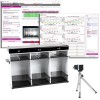Authors
DW Lim, D Han, C Lee
Lab
Korea Food Research Institute, Iksan, Cholla-bukto, South Korea
Journal
Research Square
Abstract
Excessive corticosterone (CORT), resulting from a dysregulated hypothalamicÐpituitaryÐadrenal (HPA) axis, is associated with cognitive impairment and behavioral changes, including depression. In Eastern medicine, Pedicularis resupinata var. oppositifolia (Scrophulariaceae) is used for the treatment of rheumatoid arthritis, malignant abscesses (tumors), uroliths, and diuretics. However, the antidepressant properties of P. resupinata have not been well characterized. Here, the antidepressant-like effects of P. resupinata extract (PRE) were evaluated in in vivo and in vitro CORT-induced depression models. HPLC confirmed that acteoside, a phenylethanoid glycoside, was a major PRE compound from. Male ICR mice (8 weeks old) were injected with CORT (40 mg/kg) and orally administered PRE daily (30, 100, and 300 mg/kg) for 21 consecutive days. Depressive-like behaviors were evaluated using the open field test, sucrose preference test, passive avoidance test, tail suspension test, and forced swim test. Treatment with a high dose of PRE significantly alleviated CORT-induced depression-like behaviors in mice and reduced neurotoxicity in a concentration-dependent manner in SH-SY5Y cells. Additionally, repeated CORT injection markedly reduced brain-derived neurotrophic factor (BDNF) levels, whereas total glucocorticoid receptor (GR) and GR phosphorylation at serine 211 were significantly increased in the mice hippocampus, but improved by PRE treatment. Thus, our findings suggest that PRE have potential antidepressant-like effects by modulating GR-mediated BDNF expression in the CORT-induced depressive mice model.
BIOSEB Instruments Used:
Tail Suspension Test - Wireless (BIO-TST5)

 Pain - Thermal Allodynia / Hyperalgesia
Pain - Thermal Allodynia / Hyperalgesia Pain - Spontaneous Pain - Postural Deficit
Pain - Spontaneous Pain - Postural Deficit Pain - Mechanical Allodynia / Hyperalgesia
Pain - Mechanical Allodynia / Hyperalgesia Learning/Memory - Attention - Addiction
Learning/Memory - Attention - Addiction Physiology & Respiratory Research
Physiology & Respiratory Research
 Pain
Pain Metabolism
Metabolism Motor control
Motor control Neurodegeneration
Neurodegeneration Cross-disciplinary subjects
Cross-disciplinary subjects Muscular system
Muscular system General activity
General activity Mood Disorders
Mood Disorders Other disorders
Other disorders Joints
Joints Central Nervous System (CNS)
Central Nervous System (CNS) Sensory system
Sensory system Bioseb on booth #14 at OARSI 2024 in Vienna
Bioseb on booth #14 at OARSI 2024 in Vienna 